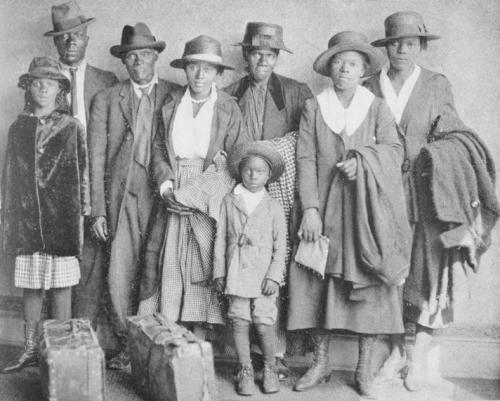
Hunger is More Than Being Hungry
March 13, 2021
Day 60: The Golden Road Home
May 18, 2021The most underreported story of the 20th century.
That’s how author Isabel Wilkerson in her book, “The Warmth of Other Suns,” describes The Great Migration, the mass exodus of Blacks from the South to other parts of the country in the first half of the 1900s.
Julia Brock, an assistant history professor at the University of Alabama, agrees.
“It was a quiet movement that happened over time,” Brock told 60 Days USA in spring 2021. “Yet, it had these revolutionary social and political shifts that are still part of our landscape in a variety of ways.”
The statistics certainly demonstrate the impact.
Between 1915 and 1970, it’s estimated that 6 million African-Americans fled the South to seek jobs and better, more free lives in the North and West.
When that migration began, about 90 percent of Black Americans lived in the South. By the 1970s, it was closer to 50 percent.
In her book, Wilkerson reports that Chicago’s population was 2 percent Black in 1900. It grew to 33 percent by 1970.
Detroit went from 1 percent Black to 44 percent during the migration years.
California had about 124,000 Black residents in 1940. That shot up in one decade to 462,000 in 1950 as people of color, many from Louisiana and Texas, poured into the Golden State for shipyard jobs, sunshine and less segregated communities.
In all, Wilkerson reports, about 900,000 Blacks left the South in the 1920s, another 480,000 in the 1930s, an extra 1.6 million in the 1940s and 1.4 million in the 1950s.
“It transformed all those places,” said Brock, who grew up in Rome, Georgia, and studies Southern history.
Most historians agree the Great Migration began during World War One, although there had been an exodus of Black Southerners in the late 1800s.
Wilkerson reports this initial surge occurred after the Civil War when white Southerners pushed back against the new freedoms guaranteed to Black Americans by the 14th and 15th amendments.
In addition, there was the 1896 U. S. Supreme Court Plessy vs. Ferguson decision that legalized “separate but equal” accommodations for Blacks and whites in schools, businesses and other places.
However, it was not the same as the mass exodus that began around 1915.
Brock said the Great Migration happened for a number of reasons.
The primary motivation was the “stranglehold of Jim Crow” instituted in the South that produced laws and regulations that restricted voting rights, segregated neighborhoods, limited where Blacks could work and squashed any chance of opportunity.
“It limited social mobility. It limited physical mobility,” said Brock. “And it certainly limited the dreams of African-Americans who lived in the South who wanted to see better lives for their children.”
There was also the rise of the Ku Klux Klan during this time period as well as violence against Blacks who dared to challenge the system. It’s estimated that between 1880 and 1950 there was an average of one African-American lynched in the United States per week.
Brock also notes that the boll weevil invasion in the early 1900s decimated the South’s cotton crop, resulting in fewer agricultural jobs.
There was also the sharp decline in immigration from Europe during World War One. That created a labor shortage in the North. The owners of steel mills, railroads and factories sought out Southern Blacks to fill vacant positions. The Pennsylvania Railroad recruited 16,000 African-Americans from the South in the 1916 alone. By 1920, it’s estimated 1.5 million Blacks were working in Northern factories.
The enticements from the North did not go over well with Southern landowners.
In reaction, officials in the South established regulations and imposed fines on out-of-state recruiters. They also tried to prevent Blacks from leaving by arresting them at train stations as “vagrants” or simply seizing their railway tickets and tearing them up.
It wasn’t all wine and roses in the North and West either.
As Blacks moved in and snapped up jobs, resentment grew among white residents.
Many large cities developed segregated sectors with practices such as “redlining” where people of color weren’t allowed to purchase or rent homes in certain areas. There were also “sundown” regulations that prevented Blacks from entering certain neighborhoods after dark. The Oregon Constitution prohibited Blacks from entering the state until the law was changed in 1926.
In addition, Black migrators were often restricted to the lowest paying and most dangerous jobs. Due to practices such as redlining, most lived in the poorest parts of town.
This scenario was captured in “A Raisin in the Sun,” the 1959 play by Lorraine Hansberry about a Black family living on Chicago’s South Side.
Still, as Wilkerson points out in her book, Blacks who were part of The Great Migration could earn more money in the North and West and didn’t have to suffer the same discrimination they faced back home.
Many of the Blacks who left returned to visit the South with nice cars, fancy clothes and stories of freedom. People in the South also read stories in African-American publications such as the Chicago Defender that encouraged people to make the move.
The visitors and articles enticed other African-Americans to join the migration. Many of the migrators, Wilkerson noted, would stay with friends and family who were already established in the North and West until they got their feet on the ground.
The impacts of The Great Migration cannot be overstated.
In the South, the exodus put a big dent in the available labor pool.
“It drained the rural Black population in the South,” Brock said.
She added that the migration also took away Black musicians, writers, educators and lawyers who could have contributed to the region.
“It was a huge brain drain,” Brock noted.
In her book, Wilkerson highlights the community leaders in the North and West who either migrated themselves or who had parents or grandparents who did. They range from former Cleveland Mayor Carl Stokes to former Detroit Mayor Coleman Young to former first lady Michelle Obama.
There are also a number of cultural icons in the same category. They include musicians Miles Davis and John Coltrane as well as author Toni Morrison, singers Diana Ross and Aretha Franklin, media executive Oprah Winfrey and baseball pioneer Jackie Robinson.
“[The migration] definitely affected what could have been [In the South],” said Brock.
In the North, the migration was nothing short of an upheaval.
“It completely shifted the demographics of the North,” Brock said.
It changed industries as well as cultural norms and inspired movements such as the Harlem Renaissance in New York City.
The same has been true in the West.
During World War Two, many Black Southerners were recruited to work in California shipyards and they transformed cities there, too.
The Great Migration finally eased in the 1970s as changes in the laws and practices in the South took away the necessity of leaving the region.
In addition, Brock points out, many Southern cities such as Atlanta have more job opportunities than places in the North and West.
The changes and resurgence have led some Black leaders to encourage descendants of those who participated in The Great Migration to return to their Southern roots.
In his book “The Devil You Know,” author Charles Blow says it’s imperative for Blacks to move back to the South to consolidate political power in key states such as Georgia. Blow says such a reverse migration could increase the economic and political power of Blacks in the South.
Brock points out that this idea has been bubbling since the 1970s.
She notes that Atlanta Mayor Maynard Jackson started a media campaign during that decade with the slogan “Black is bountiful in Atlanta” that urged African-Americans to return. She said between 1976 and 2000, about 675,000 Black Americans moved back to Southern states.
One person who was part of that trend is Sharon Weston Broome, the mayor of Baton Rouge, Louisiana.
Broome’s father, Willie, was born in a small town in Louisiana in 1903. Her mother, Lucy, was born in 1912 in a rural town in Mississippi. Both moved as young adults to Chicago, where they met and married.
Broome told 60 Days USA that her parents’ 2-story, brownstone home in Chicago was one of the places where new migrants would temporarily stay when they first arrived.
Chicago was and remains a deeply segregated city, but the Broome family stayed there until 1979. That’s when Broome’s father decided at age 76 that he couldn’t take the cold anymore. So, they moved to the warmer confines of Baton Route when Broome was in her early 20s.
“My thought was I was going to help them transition, get them all set up, and then I was going to move back to Chicago,” Broome said. “But I fell in love with Baton Rouge.”
Broome now leads her new hometown and believes a reverse migration “can certainly benefit African-Americans.”
She said the “New South” has a lower cost of living, ample job opportunities and can help Blacks born elsewhere to reconnect with their families.
Broome believes African-Americans can become a powerful force by repopulating the South, noting in spring 2021 that Louisiana’s three largest cities all had Black mayors.
“It’s a clear path to progression,” she says.
Brock also sees the lure.
“It’s absolutely appealing to folks,” she said. “They can reclaim the South as a place for Black power.”


